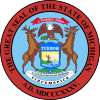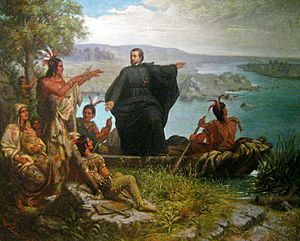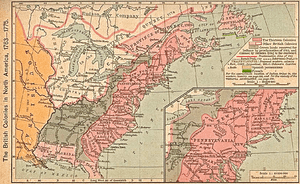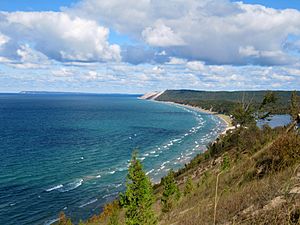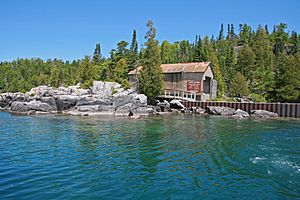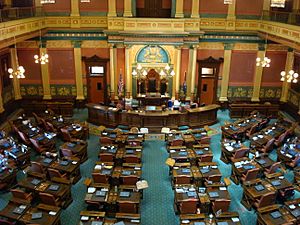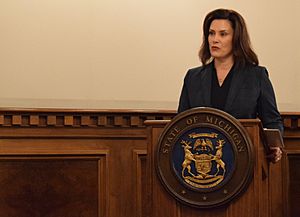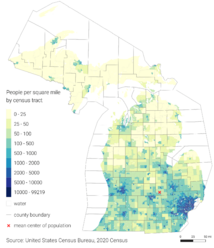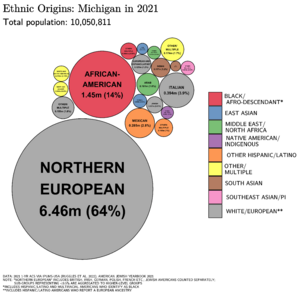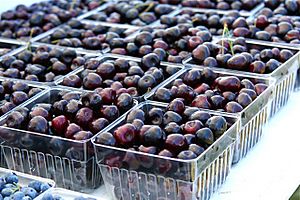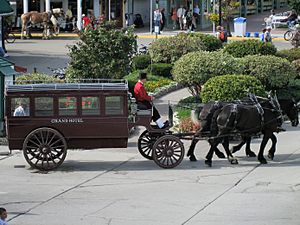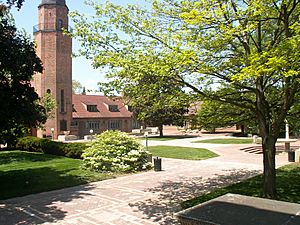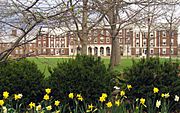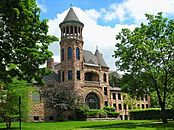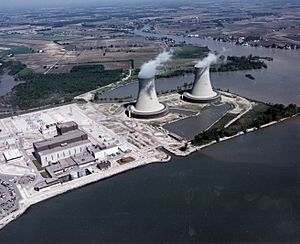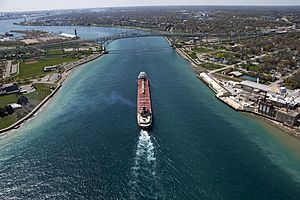Michigan facts for kids
Quick facts for kids
Michigan
|
|||
|---|---|---|---|
|
|||
| Nicknames:
"The Great Lakes State", "The Wolverine State", "Water (Winter) Wonderland"
|
|||
| Motto(s):
Si quaeris peninsulam amoenam circumspice
(English: "If you seek a pleasant peninsula, look about you") |
|||
| Anthem: "My Michigan" | |||

Location of Michigan within the United States
|
|||
| Country | United States | ||
| Before statehood | Michigan Territory | ||
| Admitted to the Union | January 26, 1837 (26th) | ||
| Capital | Lansing | ||
| Largest city | Detroit | ||
| Largest county or equivalent | Wayne | ||
| Largest metro and urban areas | Detroit | ||
| Legislature | Michigan Legislature | ||
| • Upper house | Senate | ||
| • Lower house | House of Representatives | ||
| Judiciary | Michigan Supreme Court | ||
| U.S. senators | Gary Peters (D) Elissa Slotkin (D) |
||
| U.S. House delegation | 7 Republicans 6 Democrats (list) |
||
| Area | |||
| • Total | 96,716 sq mi (250,493 km2) | ||
| • Land | 58,110 sq mi (150,504 km2) | ||
| • Water | 38,606 sq mi (99,990 km2) 41.8% | ||
| Area rank | 11th | ||
| Dimensions | |||
| • Length | 456 mi (734 km) | ||
| • Width | 386 mi (621 km) | ||
| Elevation | 900 ft (270 m) | ||
| Highest elevation | 1,979 ft (603 m) | ||
| Lowest elevation | 571 ft (174 m) | ||
| Population
(2024)
|
|||
| • Total | |||
| • Rank | 10th | ||
| • Density | 174/sq mi (67.1/km2) | ||
| • Density rank | 17th | ||
| • Median household income | $71,100 (2023) | ||
| • Income rank | 32nd | ||
| Demonym(s) | Michigander, Michiganian, Yooper (Upper Peninsula) | ||
| Language | |||
| • Official language | None (English, de facto) | ||
| • Spoken language | English 91.11% Spanish 3.86% Arabic 1.05% Other 4.92% |
||
| Time zones | |||
| Most of state | UTC−05:00 (Eastern) | ||
| • Summer (DST) | UTC−04:00 (EDT) | ||
| 4 U.P. counties (Gogebic, Iron, Dickinson, and Menominee) | UTC−06:00 (Central) | ||
| • Summer (DST) | UTC−05:00 (CDT) | ||
| USPS abbreviation |
MI
|
||
| ISO 3166 code | US-MI | ||
| Traditional abbreviation | Mich. | ||
| Latitude | 41°41′ N to 48°18′ N | ||
| Longitude | 82°7′ W to 90°25′ W | ||
| Bird | American robin (Turdus migratorius) |
|---|---|
| Fish | Brook trout (Salvelinus fontinalis) |
| Flower | Apple blossom (Malus domestica) Wildflower: Dwarf lake iris (Iris lacustris) |
| Tree | Eastern white pine (Pinus strobus) |
Michigan ( mish-IG-ən) is a state located in the Great Lakes area of the Upper Midwestern United States. It shares borders with Minnesota, Wisconsin, Indiana, Illinois, Ohio, and the Canadian province of Ontario. Michigan is home to over 10 million people and covers about 96,716 square miles. This makes it the 10th largest state by population and the 11th largest by land area. It is also the largest state east of the Mississippi River in terms of total area.
The state capital is Lansing, but its biggest city is Detroit. The Metro Detroit area is one of the largest and most important economic centers in the country. Other major cities include Grand Rapids, Flint, Ann Arbor, and Kalamazoo.
Michigan is unique because it has two main parts: the Upper Peninsula (often called "the U.P.") and the more populated Lower Peninsula. These two parts are separated by the Straits of Mackinac, which connects Lake Michigan and Lake Huron. They are joined by the amazing 5-mile-long Mackinac Bridge. Michigan borders four of the five Great Lakes and has the longest freshwater coastline of any U.S. state, stretching 3,288 miles. About 42% of the state's area is covered by water, and it has nearly 65,000 inland lakes and ponds.
Hundreds of years ago, Indigenous peoples like the Ojibwe, Odawa, Potawatomi, and Wyandot lived here. In the 1600s, French explorers arrived and claimed the region for New France. The name "Michigan" comes from the Ojibwe word mishigami, meaning "large water" or "large lake." After a war in 1762, the British took control, and then the U.S. gained it after the Treaty of Paris (1783). Michigan officially became the 26th U.S. state on January 26, 1837. It joined as a free state and quickly became a hub for industry and trade, attracting many immigrants.
Today, Michigan has a diverse economy. It is especially famous as the center of the U.S. automotive industry. The headquarters of the country's three major car companies are all in Metro Detroit. The Upper Peninsula, once known for logging and mining, is now a popular place for tourism because of its beautiful natural areas. The Lower Peninsula focuses on manufacturing, forestry, agriculture, services, and high-tech industries.
Contents
- Michigan's Rich History
- Exploring Michigan's Geography
- Michigan's Government System
- People and Cultures of Michigan (Demographics)
- Michigan's Economy and Industries
- Michigan's Culture and Arts
- Education in Michigan
- Michigan's Infrastructure and Transportation
- Michigan's State Symbols and Nicknames
- Sister Regions
- See also
Michigan's Rich History
Early Native American Life
When the first European explorers arrived, many Native American tribes lived in Michigan. The most common groups were the Algonquian peoples, including the Ojibwe, Odawa, and Potawatomi. These three nations lived peacefully together as part of a group called the Council of Three Fires. The Ojibwe were the largest group, with an estimated 35,000 people.
The Ojibwe lived in Michigan's Upper Peninsula and northern and central Michigan. The Ottawa Indians mainly lived south of the Straits of Mackinac. The Potawatomi were found in southern and western Michigan. Other tribes like the Mascouten, Menominee, Miami, Sac, and Meskwaki also lived in the south and east. The Wyandot, who spoke an Iroquoian language, were also in this area.
European Exploration and Settlement (1600s-1700s)
French explorers and traders first came to Michigan in the 1600s. The first Europeans to reach Michigan were part of Étienne Brûlé's group in 1622. The first lasting European settlement was started in 1668. This was when Père Jacques Marquette created Sault Ste. Marie, Michigan, as a base for Catholic missions. Missionaries also set up stations in Saint Ignace and Marquette. The local Native American groups welcomed the missionaries.
In 1701, French explorer Antoine de la Mothe Cadillac founded Fort Pontchartrain du Détroit (now Detroit). He believed a permanent settlement would help France control the Great Lakes and stop the British. The fort quickly became a major center for fur trading and shipping. Cadillac's wife, Marie Thérèse Guyon, was one of the first European women to settle in Michigan's wilderness.
By the mid-1700s, France also had forts in present-day Niles and Sault Ste. Marie. Detroit grew to 800 people by 1765, making it the largest city between Montreal and New Orleans.
After the French and Indian War (1754–1763), France lost control of Michigan to Great Britain in 1763. Michigan then became part of the British Province of Quebec. By 1778, Detroit had over 2,000 people.
After the American Revolutionary War, the Treaty of Paris (1783) gave Michigan to the new United States. However, the British kept control of Detroit and Michigan until 1796 due to unclear boundary lines.
Becoming a State (1800s)
During the War of 1812, American forces at Fort Detroit surrendered Michigan Territory to the British in 1812. Michigan was taken back by the Americans in 1813 after the Battle of Lake Erie.
The population of Michigan grew slowly until the Erie Canal opened in 1825. This canal connected the Great Lakes to the Hudson River and New York City. This new route brought many settlers to Michigan. They became farmers, lumberjacks, shipbuilders, and merchants. By the 1830s, Michigan had enough people to become a state.
Michigan officially became the 26th state on January 26, 1837. It joined as a free state. The Upper Peninsula turned out to be rich in lumber, iron, and copper. Michigan led the country in lumber production from the 1850s to the 1880s. Railroads also helped the state grow, with Detroit as a major center.
The first statewide meeting of the Republican Party happened in Jackson, Michigan, on July 6, 1854. Michigan played a big part in the American Civil War, sending many volunteers to fight for the Union.
Michigan also improved its education system during this time. Eastern Michigan University was founded in 1849 to train teachers. Michigan State University was founded in 1855 as the first agricultural college in the nation.
Michigan in the 20th and 21st Centuries

Michigan's economy changed a lot around 1900. People like Henry Ford helped create the automotive industry. Ford's invention of the moving assembly line in Highland Park changed how cars were made. This made cars more affordable and changed life in the United States and around the world.
The growing auto industry created many jobs in Detroit. This attracted immigrants from Europe and people from other parts of the U.S., including the rural South. By 1920, Detroit was the fourth-largest city in the U.S. Many different languages were spoken in schools, and various cultures celebrated their heritage. Detroit also became famous for its music, including the Motown Sound in the 1960s.
Grand Rapids, Michigan's second-largest city, also became an important manufacturing center. It is known for its furniture industry and is home to major companies like Steelcase and Amway.
During World War II, Michigan's factories made a lot of military equipment. The state produced 10.9% of all U.S. military weapons during the war, ranking second in the nation.
Detroit continued to grow through the 1950s. After the war, new housing was built in the suburbs. The government also built interstate highways, making travel easier. Since 1960, the auto industry has become more automated, and high-tech industries have grown. Michigan is still the leading auto-producing state in the U.S.
Exploring Michigan's Geography
Land and Water Features

Michigan is made up of two peninsulas, separated by the Straits of Mackinac. The 45th parallel north runs through the state, marked by signs. Almost all of Michigan's land drains into the Great Lakes and the St. Lawrence watershed. No spot in Michigan is more than 6 miles (9.7 km) from a natural water source. Also, no place is more than 85 miles (137 km) from a Great Lakes shoreline.
The Great Lakes that border Michigan are Lake Erie, Lake Huron, Lake Michigan, and Lake Superior. Michigan shares land and water borders with Ohio and Indiana to the south. To the west, it borders Illinois and Wisconsin in Lake Michigan. It also has a land border with Wisconsin in the Upper Peninsula. To the north and east, it borders the Canadian province of Ontario.
The Upper Peninsula (U.P.)
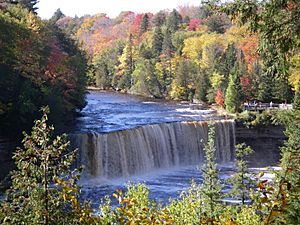
The Upper Peninsula is heavily forested and has mountains in the west. The Porcupine Mountains are part of one of the oldest mountain ranges in the world. They rise almost 2,000 feet (610 m) above sea level. The highest point in Michigan, Mount Arvon, is in the Huron Mountains at 1,979 feet (603 m). The U.P. is a large area, but it has fewer than 330,000 residents. People from the U.P. are sometimes called "Yoopers." Their way of speaking has been influenced by many Scandinavian and Canadian immigrants who settled there for lumbering and mining.
The Lower Peninsula
The Lower Peninsula is shaped like a mitten, and many residents use their hand to show where they live. It is 277 miles (446 km) long from north to south and 195 miles (314 km) from east to west. It covers almost two-thirds of the state's land area. The land is mostly flat, with some hills and glacial moraines. The highest point in the Lower Peninsula is about 1,705 feet (520 m) near Cadillac. The lowest point is the surface of Lake Erie at 571 feet (174 m).
The distance between the ends of Michigan's peninsulas is very long. For example, Ironwood in the far western Upper Peninsula is about 630 miles (1,010 km) by road from Lambertville in the Lower Peninsula's southeastern corner. This distance makes the Upper Peninsula feel culturally and economically different from the rest of Michigan.
A special part of Michigan's Lower Peninsula is the Thumb, which sticks out into Lake Huron and forms Saginaw Bay. Other important peninsulas include the Keweenaw Peninsula in the U.P., known for its copper mining history, and the Leelanau Peninsula in the Lower Peninsula, which looks like Michigan's "little finger."
Michigan has many lakes and marshes. Its coastline is very long, at 3,288 miles (5,292 km), including 1,056 miles (1,700 km) of island shoreline. The state also has about 150 lighthouses, more than any other U.S. state. These lighthouses helped guide ships on the Great Lakes.
The state's rivers are generally small and shallow. Major rivers include the Detroit River, St. Marys River, and St. Clair River, which connect the Great Lakes. Other rivers flow into Lake Huron, Lake Superior, and Lake Michigan. Michigan has 11,037 inland lakes.
National and State Parks
Michigan is home to several areas managed by the National Park Service. These include Isle Royale National Park in Lake Superior, Keweenaw National Historical Park, Pictured Rocks National Lakeshore, and Sleeping Bear Dunes National Lakeshore. There are also several national forests like Huron National Forest and Hiawatha National Forest.
With 78 state parks, 19 state recreation areas, and six state forests, Michigan has the largest state park and state forest system in the nation.
Michigan's Climate
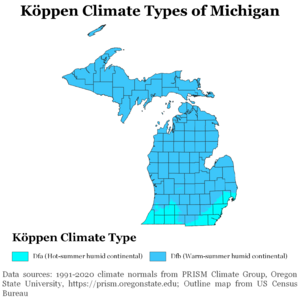
Michigan has a continental climate with two main regions. The southern and central parts of the Lower Peninsula have warmer summers and cold winters. The northern Lower Peninsula and the entire Upper Peninsula have colder winters and shorter, warm summers. In winter, especially in the north, temperatures can stay below freezing for months.
The state gets about 30 to 40 inches (76 to 102 cm) of rain each year. Some northern areas get a lot of lake-effect snow, sometimes almost 160 inches (410 cm) per year. Michigan averages 30 days of thunderstorms annually, which can be strong in the southern part of the state. The state also sees about 17 tornadoes each year, mostly in the far south.
Geology of Michigan
Michigan's geology is quite varied. The Michigan Basin is the most important geological feature. The Upper Peninsula has older rocks, including copper and iron-bearing rocks. The Lower Peninsula has younger deposits, including coal.
Michigan rarely has earthquakes. When they do happen, they are usually small and don't cause much damage. A 4.2-magnitude earthquake happened in central Michigan in 2015, but no major damage was reported.
How Michigan is Divided (Administrative Divisions)
Michigan's government is divided into three levels: state, county, and township. Counties and townships help the state government manage local needs. There are 83 counties in Michigan.
Cities, state universities, and villages have different levels of home rule powers. This means they can make many of their own rules. Cities can generally do anything not forbidden by law. State universities have broad powers for education. Villages have more limited home rule and are still connected to their county and township.
There are two types of townships: general law and charter. A Charter township has more powers and better protection against being taken over by a city. Charter townships can have their own fire, water, and police departments, similar to cities, but they are not required to. They can choose to use county services instead.
| Rank | Name | Pop. |
|---|---|---|
| 1 | Detroit | 639,111 |
| 2 | Grand Rapids | 198,917 |
| 3 | Warren | 139,387 |
| 4 | Sterling Heights | 134,346 |
| 5 | Ann Arbor | 123,851 |
| 6 | Lansing | 112,644 |
| 7 | Dearborn | 109,976 |
| 8 | Clinton Charter Township | 100,513 |
| 9 | Canton Charter Township | 98,659 |
| 10 | Livonia | 95,535 |
Michigan's Government System
Michigan's government is set up like a republic, with three main parts:
- The executive branch includes the Governor of Michigan and other elected officials.
- The legislative branch makes laws and has two parts: the House of Representatives and the Senate.
- The judicial branch interprets laws.
The Michigan Constitution allows citizens to get involved directly by proposing and voting on laws. Lansing is the state capital and home to all three branches of government.
The governor and other state officials serve four-year terms and can be re-elected once. The lieutenant governor is elected with the governor and leads the Senate. The secretary of state is in charge of elections and many licensing programs.
The Michigan Legislature has 38 members in the Senate and 110 members in the House of Representatives. Senators serve four-year terms, and representatives serve two-year terms. The Michigan State Capitol building has been used by the government since 1879.
Michigan's court system has different levels. District Courts handle smaller cases like traffic violations and misdemeanors. Circuit Courts handle more serious civil cases and all felonies. The Michigan Court of Appeals reviews decisions from lower courts. The Michigan Supreme Court is the highest court in the state. Judges are elected for six-year terms.
People and Cultures of Michigan (Demographics)
| Historical population | |||
|---|---|---|---|
| Census | Pop. | %± | |
| 1800 | 3,757 | — | |
| 1810 | 4,762 | 26.8% | |
| 1820 | 7,452 | 56.5% | |
| 1830 | 28,004 | 275.8% | |
| 1840 | 212,267 | 658.0% | |
| 1850 | 397,654 | 87.3% | |
| 1860 | 749,113 | 88.4% | |
| 1870 | 1,184,059 | 58.1% | |
| 1880 | 1,636,937 | 38.2% | |
| 1890 | 2,093,890 | 27.9% | |
| 1900 | 2,420,982 | 15.6% | |
| 1910 | 2,810,173 | 16.1% | |
| 1920 | 3,668,412 | 30.5% | |
| 1930 | 4,842,325 | 32.0% | |
| 1940 | 5,256,106 | 8.5% | |
| 1950 | 6,371,766 | 21.2% | |
| 1960 | 7,823,194 | 22.8% | |
| 1970 | 8,875,083 | 13.4% | |
| 1980 | 9,262,078 | 4.4% | |
| 1990 | 9,295,297 | 0.4% | |
| 2000 | 9,938,444 | 6.9% | |
| 2010 | 9,883,640 | −0.6% | |
| 2020 | 10,077,331 | 2.0% | |
| 2023 (est.) | 10,037,261 | 1.6% | |
| Sources: 1910–2020 2022 |
|||
Michigan's population has grown steadily since 1800. In 2020, it had over 10 million residents, making it the third most populated state in the Midwest. The middle point of Michigan's population is in Shiawassee County.
In 2019, about 6.8% of people in Michigan were immigrants. Most immigrants came from Mexico, India, Iraq, China, and Canada. They often worked in technology, agriculture, and healthcare.
Diverse Ethnic Backgrounds
| Self-identified race | 1970 | 1990 | 2000 | 2010 | 2020 |
|---|---|---|---|---|---|
| White | 88.3% | 83.4% | 80.1% | 78.9% | 73.9% |
| Black or African American | 11.2% | 13.9% | 14.2% | 14.2% | 13.7% |
| Asian | 0.2% | 1.1% | 1.8% | 2.4% | 3.3% |
| American Indian | 0.2% | 0.6% | 0.6% | 0.6% | 0.6% |
| Native Hawaiian and other Pacific Islander |
— | — | — | — | — |
| Other race | 0.2% | 0.9% | 1.3% | 1.5% | 2.2% |
| Two or more races | — | — | 1.9% | 2.3% | 6.3% |
Most of Michigan's population has always been white. Many people have German, British, Irish, Polish, and Belgian backgrounds. People of Scandinavian and Finnish descent are common in the Upper Peninsula. Western Michigan is known for its Dutch heritage, especially in Holland and Grand Rapids.
Dearborn has a large Arab American community. Many Assyrian/Chaldean/Syriac and Lebanese people moved there for jobs in the auto industry. Michigan also has a notable Hmong community, especially in the Lansing area.
Many Japanese people live in the Detroit and Ann Arbor areas. They often moved there for jobs and good schools.
Languages Spoken in Michigan
In 2010, about 91% of Michigan residents aged five and older spoke only English at home. Spanish was the second most common language, spoken by about 2.9% of the population. Other languages spoken include Arabic, German, Chinese, French, Polish, and Syriac languages. Overall, about 8.9% of Michigan's population spoke a language other than English at home.
Religion in Michigan
Religious self-identification, per Public Religion Research Institute's 2021 American Values Survey Protestantism (43%) Catholicism (24%) Jehovah's Witness (1%) Unaffiliated (28%) Judaism ({{{value5}}}%) Other (2%)
After European settlement, Christianity became the main religion in Michigan. Roman Catholicism was historically the largest Christian group. Detroit's St. Anne's parish, founded in 1701, is one of the oldest Catholic churches in the U.S.
Today, Protestant churches form the largest group of Christians. In 2020, non-denominational Protestant churches were the largest Protestant group. The Lutheran Church–Missouri Synod and United Methodist Church are also very large. Many Dutch immigrants settled in West Michigan around 1850, bringing their Reformed churches with them.
In 2010, there were about 44,382 Jewish people and 120,351 Muslims in Michigan. The first Jewish synagogue in the state was founded in Detroit in 1850. Islam was brought by immigrants from the Near East. Michigan is home to the largest mosque in North America, the Islamic Center of America in Dearborn. The Seventh-day Adventist Church was founded in Battle Creek, Michigan, in 1863.
Michigan's Economy and Industries
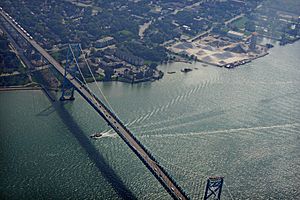
In 2017, nearly 3.9 million people worked in Michigan. The state's total economic output was about $645 billion in early 2023, ranking 14th among all states. In August 2023, Michigan's unemployment rate was 3.7%.
Michigan produces many goods and services, including automobiles, food products, information technology, aerospace, military equipment, and furniture. It also mines copper and iron ore. Michigan is the third-largest grower of Christmas trees in the U.S.
Famous Michigan-born beverages include Vernors Ginger Ale (invented in 1866) and Faygo (founded in Detroit in 1907). Two of the top four pizza chains, Domino's Pizza and Little Caesars, were also founded and are headquartered in Michigan.
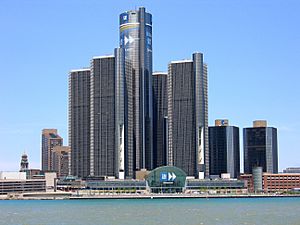
Michigan is well-known as the center of the U.S. automotive industry. The headquarters of the country's three major car companies (General Motors, Ford, and Chrysler) are all in Metro Detroit. The auto industry creates many jobs, directly and indirectly, across the U.S.
Michigan is a leader in research and development (R&D) spending. Its R&D, including automotive research, makes up a higher percentage of the state's economy than in any other U.S. state. The state has many engineering job opportunities.
Detroit Metropolitan Airport is one of the busiest airports in North America. Michigan's schools and colleges are highly rated. The state has 38 deep water ports, which are important for trade.
In 2019, Michigan legalized online gambling activities, allowing casinos to offer internet gaming.
Taxes in Michigan
Michigan has a flat personal income tax rate of 4.25%. Some cities also have their own income taxes. The state sales tax is 6%, but food and medicine are not taxed. Property taxes are collected locally and help fund schools. In 2011, Michigan replaced its business tax with a 6% corporate income tax, which lowered taxes for businesses.
Agriculture in Michigan
Michigan grows a wide variety of crops, fruits, and vegetables. It is second only to California in the diversity of its agriculture. In 2010, Michigan had 54,800 farms that sold $6.49 billion worth of products. Milk is the most valuable agricultural product. Other important crops include corn, soybeans, flowers, wheat, sugar beets, and potatoes.
Michigan is a leading grower of fruits like blueberries, tart cherries, apples, grapes, and peaches. These fruits are mostly grown in West Michigan because Lake Michigan helps keep the climate mild. Michigan also produces wines, beers, and many processed food products. Kellogg's cereal company is based in Battle Creek, Michigan, and uses many local foods.
The Saginaw Valley and Thumb areas have very fertile land. They grow corn, sugar beets, navy beans, and soybeans. Michigan's largest sugar refiner, Michigan Sugar Company, is the biggest east of the Mississippi River.
Tourism and Recreation
In 2011, tourists spent $17.2 billion in Michigan, supporting 193,000 tourism jobs. Michigan's forests, lakes, and thousands of miles of beaches are major attractions. Events like the Tulip Time Festival and the National Cherry Festival also draw many visitors.
Tourism in metropolitan Detroit brings people to places like The Henry Ford museum, the Detroit Institute of Arts, and the Detroit Zoo. The metro area also has four major casinos.
Hunting and fishing are big industries in Michigan. The state has the most licensed hunters in the nation (over one million). Many schools in rural Michigan even close on the first day of deer hunting season because so many students participate.
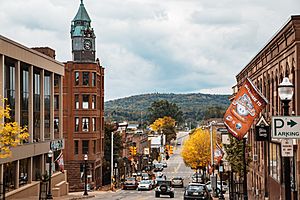
Michigan's Department of Natural Resources manages the largest state forest system in the country. The state has the most golf courses and registered snowmobiles in the nation.
Michigan is also a great place for scuba diving because of the many shipwrecks in the Great Lakes. The Michigan Underwater Preserves protect these wrecks for divers to explore.
Michigan's Culture and Arts
Music Scene
Michigan music is known for three main styles: early punk rock, Motown/soul music, and techno music. Famous musicians from Michigan include the Supremes, Stevie Wonder, Marvin Gaye, Aretha Franklin, Madonna, Bob Seger, and Eminem.
Performance Arts Venues
Major theaters in Michigan include the Fox Theatre, Music Hall, Gem Theatre, and the Detroit Opera House. The Nederlander Organization, which controls many Broadway shows in New York City, started in Detroit.
Sports in Michigan
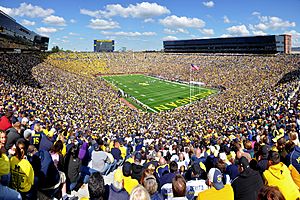
Michigan has several major-league sports teams:
- The Detroit Tigers (baseball)
- The Detroit Lions (football)
- The Detroit Red Wings (ice hockey)
- The Detroit Pistons (men's basketball)
All of these teams play in the Metro Detroit area. Michigan also has a professional soccer team, Detroit City FC.
The Michigan International Speedway hosts NASCAR races. Michigan is also home to the Au Sable River Canoe Marathon, a 120-mile canoeing race. The Port Huron to Mackinac Boat Race is another popular event.
Famous athletes from Michigan include tennis champion Serena Williams (born in Saginaw) and Olympic gymnast Jordyn Wieber (from DeWitt).
College sports are also very popular. The Michigan Wolverines and Michigan State Spartans are two of the state's biggest college athletic programs. Michigan Stadium in Ann Arbor, home to the Wolverines football team, is the largest stadium in the Western Hemisphere.
Education in Michigan
Michigan's public school system serves about 1.6 million students from kindergarten through 12th grade. Over 124,000 students attend private schools. In 2022, U.S. News & World Report ranked three Michigan high schools among the nation's top 100: City High Middle School, the International Academy of Macomb, and the International Academy.
The University of Michigan is Michigan's oldest higher education school, founded in 1817. Kalamazoo College is the state's oldest private liberal arts college, started in 1833. Albion College was founded in 1835 and is the state's second-oldest private liberal arts college.
Michigan Technological University was founded in 1885 in the Upper Peninsula. Eastern Michigan University was founded in 1849 to train teachers. Michigan State University was founded in 1855 as the nation's first agricultural college.
The Carnegie Foundation lists eight of Michigan's universities as research universities. These include the University of Michigan, Michigan State University, and Wayne State University. These universities attract over $1.5 billion in research grants each year.
Michigan's Infrastructure and Transportation
Energy Production
In 2020, Michigan produced 116,700 gigawatt-hours (GWh) of electrical energy. Coal power is a major source of electricity, making up about half of the state's supply. However, many coal plants are closing because natural gas is cheaper.
Nuclear power is also a big source of electricity in Michigan, providing about a quarter of the state's power. The three active nuclear power plants supply about 26% of Michigan's electricity.
Michigan has been increasing its use of renewable energy. By the end of 2021, utilities were required to get at least 15% of their energy from renewable sources, a goal they met. Wind energy made up 59% of Michigan's renewable energy in 2021.
Getting Around: Transportation
International Crossings
Michigan has nine international road crossings with Ontario, Canada. The Ambassador Bridge between Detroit and Windsor, Ontario, is the busiest international border crossing in North America for trade. Another major crossing is the Blue Water Bridge between Port Huron and Sarnia, Ontario. A second international bridge, the Gordie Howe International Bridge, is being built between Detroit and Windsor.
Railroads
Michigan is served by four major Class I railroads: the Canadian National Railway, the Canadian Pacific Railway, CSX Transportation, and the Norfolk Southern Railway. Most rail service in Michigan is for freight (moving goods). Amtrak offers passenger train services on three routes: the Pere Marquette, the Blue Water, and the Wolverine.
Roadways
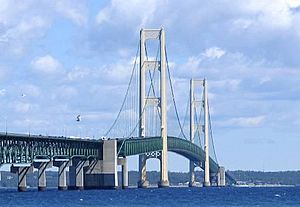
Michigan has a network of interstate highways and U.S. routes:
- I-75 is a main highway connecting Detroit, Flint, and Saginaw, and goes north to Sault Ste. Marie. It crosses the Mackinac Bridge.
- I-69 enters Michigan near the Ohio-Indiana border and goes to Port Huron.
- I-94 runs from the western side of the state through Detroit to Port Huron. It is a key route between Chicago and Detroit.
- I-96 runs east-west between Detroit and Muskegon.
- U.S. Highway 2 (U.S. 2) travels through the Upper Peninsula, following the northern shore of Lake Michigan.
- U.S. Highway 23 enters from Ohio and goes north, sometimes merging with I-75.
- U.S. Highway 31 follows the eastern shore of Lake Michigan.
- U.S. Highway 127 generally follows the Michigan meridian, a north-south survey line.
- U.S. Highway 131 runs north through Kalamazoo and Grand Rapids.
Airports
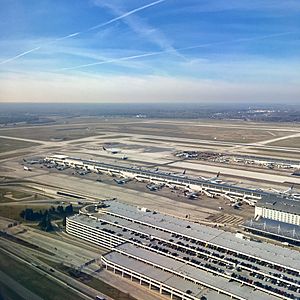
Detroit Metropolitan Airport (DTW) is one of North America's busiest airports. The Gerald R. Ford International Airport in Grand Rapids is the next busiest, followed by Flint Bishop International Airport. Other important airports serve Traverse City, Kalamazoo, Lansing, and the Midland-Bay City-Saginaw area. Smaller regional airports are found throughout the state, including on several islands.
Michigan's State Symbols and Nicknames

Michigan is often called "The Wolverine State," and the University of Michigan uses the wolverine as its mascot. This nickname has been around for a long time. However, wolverines are very rare in Michigan. The first confirmed sighting in 200 years was in 2004, and that animal was found deceased in 2010.
- State nicknames: Wolverine State, Great Lake State, Mitten State, Water-Winter Wonderland
- State motto: Si quaeris peninsulam amoenam circumspice (Latin: "If you seek a pleasant peninsula, look about you"). This motto was adopted in 1835.
- State song: "My Michigan" (official since 1937)
- State bird: American robin (since 1931)
- State animal: wolverine (traditional)
- State game animal: white-tailed deer (since 1997)
- State fish: brook trout (since 1965)
- State reptile: painted turtle (since 1995)
- State fossil: mastodon (since 2000)
- State flower: apple blossom (official in 1997)
- State wildflower: dwarf lake iris (since 1998), a threatened species.
- State tree: white pine (since 1955)
- State stone: Petoskey stone (since 1965). It is made of fossilized coral.
- State gem: Isle Royale greenstone (since 1973). Also called chlorastrolite, found on Isle Royale.
- State quarter: U.S. coin issued in 2004 with the motto "Great Lakes State."
- State soil: Kalkaska sand (since 1990), covering nearly 1 million acres.
Sister Regions
 Shiga Prefecture, Japan
Shiga Prefecture, Japan Sichuan Province, People's Republic of China
Sichuan Province, People's Republic of China
See also
 In Spanish: Míchigan para niños
In Spanish: Míchigan para niños



